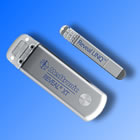|
The observational real-world study, which is being presented at theAmerican Stroke Association's International Stroke Conference 2015 in Nashville, Tennessee, this week, evaluated 1,247 cryptogenic stroke patients across the U.S. to determine whether atrial fibrillation (AF) could be detected using long-term, continuous cardiac monitoring (Reveal LINQ ICM). At 182 days of monitoring (median), AF was detected in 147 patients, resulting in an AF detection rate of 12.2 percent, which was nominally 37 percent higher than the rate observed in CRYSTAL AF at the same time point. "Unlike a randomized study, an observational study provides a practical way to study real-world clinical practice. What's most exciting is that the detection of AF in real clinical practice exceeded that observed in the rigorously-controlled CRYSTAL AF study, allowing physicians to intervene even more with stroke preventive therapies," said study co-author Mark Richards, Ph.D., M.D., director of Arrhythmia Services at ProMedica Physicians Cardiology in Toledo, Ohio. "This suggests that AF may go undetected at an even greater rate and reinforces the benefits of long-term rhythm monitoring in cryptogenic stroke patients." Atrial fibrillation is a common cardiac condition when the heart beats irregularly or rapidly; patients with AF are five times more likely to have a stroke1 due to small blood clots that may form in the heart and subsequently travel to the brain, obstructing a major blood vessel leading to an ischemic stroke. Each year, approximately 692,000 Americans experience ischemic strokes (the most common type of stroke); cryptogenic strokes account for approximately 20 - 40 percent of ischemic strokes in the majority of modern stroke registries and databases.2-8 Undiagnosed AF is believed to be responsible for a significant portion of cryptogenic strokes; however, because AF often has no symptoms, it may not be detected by conventional monitoring techniques such as in-hospital monitoring, electrocardiography or traditional ambulatory cardiac monitors such as a Holter. Unlike conventional monitoring methods, the Reveal LINQ ICM automatically and continuously detects and records abnormal heart rhythms for up to three years. Continuous Cardiac Monitoring is Cost-Effective In the CRYSTAL AF study, detection of AF with the long-term cardiac monitor was superior to conventional monitoring methods (30.0 percent with the ICM, and 3.0 percent with standard monitoring at 3 years; p=<0.0001) that are the current standard of care over a three-year follow up. "These results show that continuous cardiac monitoring with an ICM is a cost-effective tool," said Klaus Witte, M.D., FRCP, FESC, FACC, associate professor and consultant cardiologist, and lead clinician for cardiology at the University of Leeds and Leeds Teaching Hospitals NHS Trust in the United Kingdom. "Detecting AF in cryptogenic stroke patients enables physicians to change their medical therapy so we can reduce their risk of having a second stroke." Cleared by the FDA last year, the Reveal LINQ ICM System is the newest generation of ICM and the smallest cardiac monitor available (~1 cc, or one-third the size of a AAA battery). Common uses include monitoring syncope patients for potential episodes of bradycardia/asystole, monitoring cryptogenic stroke patients for possible episodes of AF, and monitoring patients suffering from intermittent chest palpitations for potential episodes of atrial or ventricular arrhythmias. Like its predecessor, this even smaller LINQ device is placed under the skin of the chest, and its battery allows for up to three years of monitoring. Additionally, the device communicates wirelessly with a patient bedside monitor that uploads device data to the Medtronic CareLink® network. In collaboration with leading clinicians, researchers and scientists worldwide, Medtronic offers the broadest range of innovative medical technology for the interventional and surgical treatment of cardiovascular disease and cardiac arrhythmias. The company strives to offer products and services that deliver clinical and economic value to healthcare consumers and providers around the world. About Medtronic Any forward-looking statements are subject to risks and uncertainties such as those described in Medtronic's periodic reports on file with the Securities and Exchange Commission. Actual results may differ materially from anticipated results.
|

